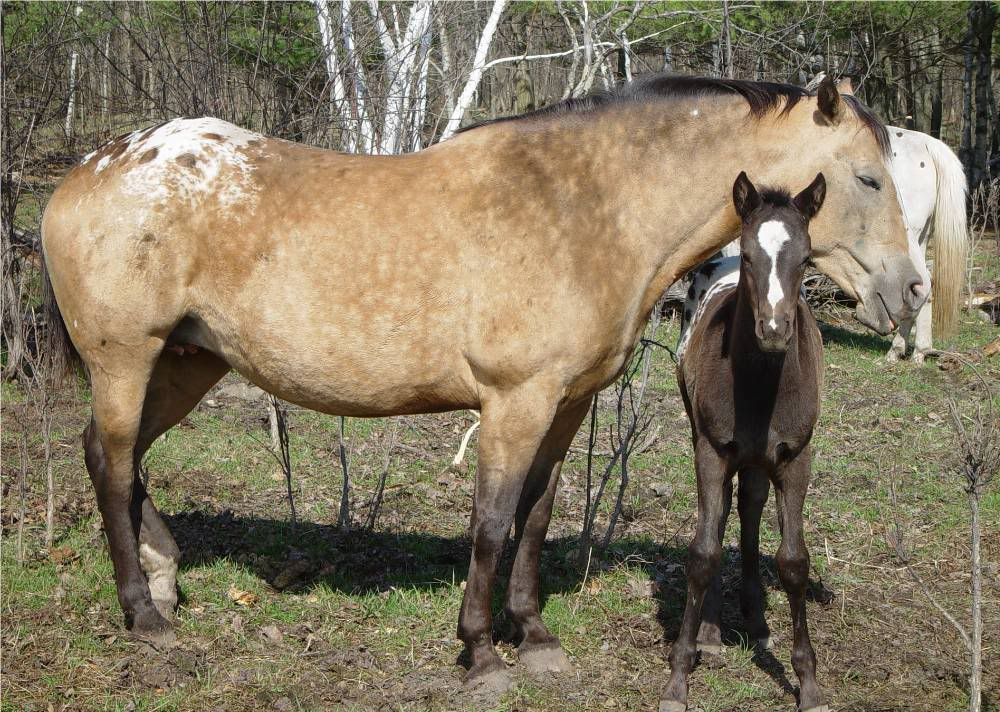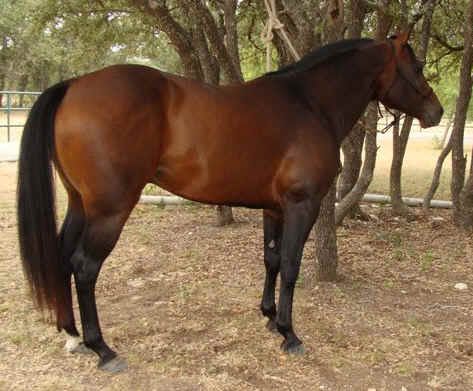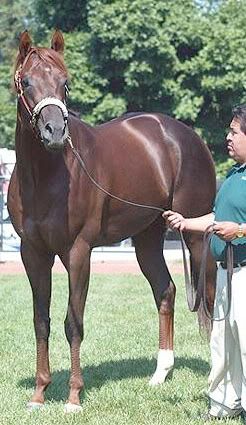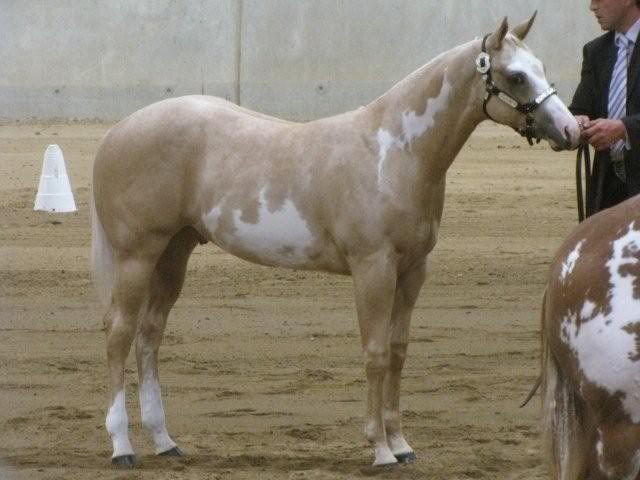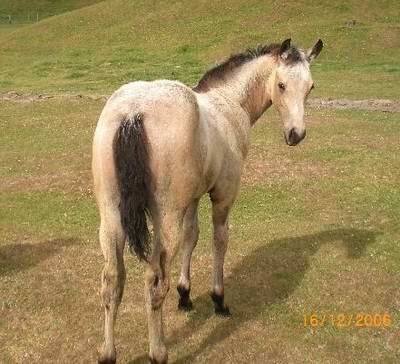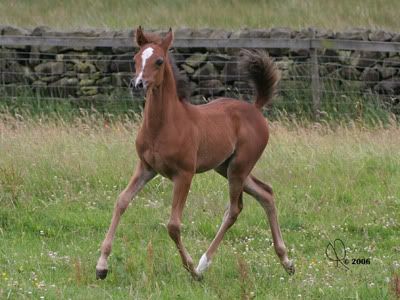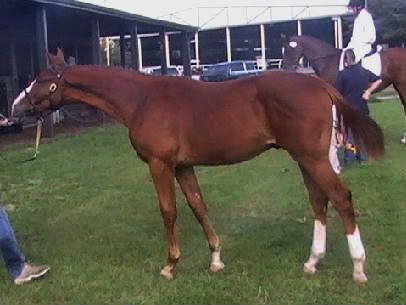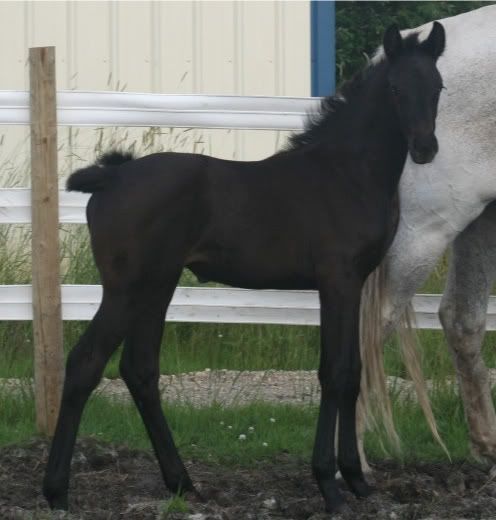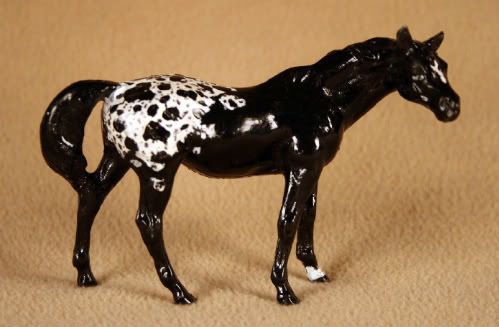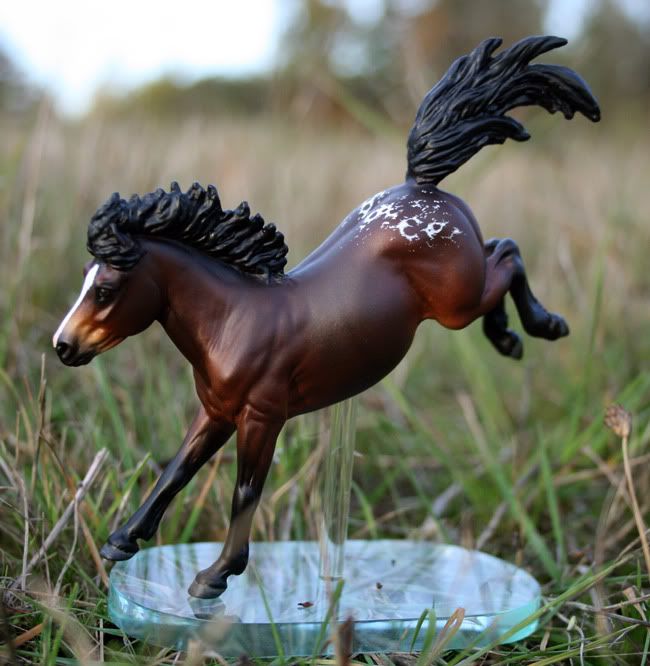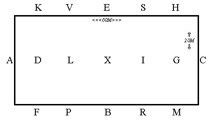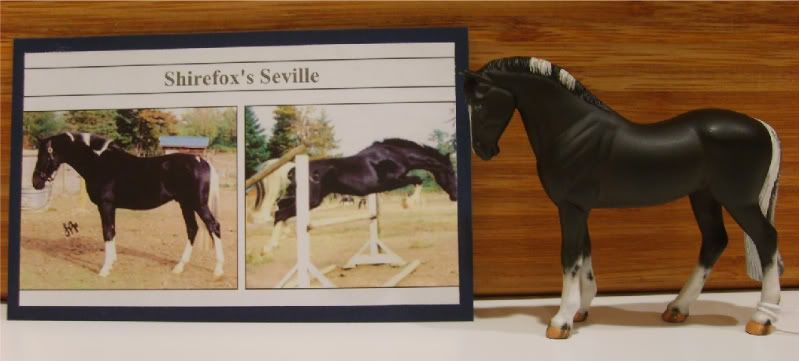Wednesday, December 30, 2009
Where to Find Shows
NAMHSA - Member Shows
This list is all NAN-Qualifying shows. Many shows are announced before they are approved for their NAN-cards, so this list is not always the most up-to-date. By the time a show is listed on this site, it may be full.
Model Horse Blab, Fallen Leaves, The Watering Hole
All three of these are discussion boards. Showholders will often announce their upcoming shows here, but not every showholder is a member of every board.
Model Horse Gallery - Live Show Listings
Gail does a great job of keeping this list up-to-date. A great resource.
Your Region Yahoo Group
I'll link to each of these tomorrow when I cover the topic of Regions in more depth.
These are the resources I use. If I missed your favorite, please link it in the comments!
Tuesday, December 29, 2009
Shows Fill Up: Sign up Early!
Big shows, small shows, medium shows: they all can sell out quickly. Most of the time, you'll be fine if you send in an entry with a couple weeks of the show. However, I recommend sending in an entry at least a month before: the sooner, the better.
Breyerfest is, by far, the most popular show in the US. The show is held in July, but it sells out around mid-March, within a couple weeks of when Breyer starts excepting entries. If you are interested in showing at Breyerfest, you need to be aware of the date entries open. On that date, send in your entry by some sort of express mail. I Fed-Ex mine. For my first Breyerfest, I sent my entry by snail mail. It made it there, but I was shower 99 out of 100.
NAN is a different ballgame. First, if your are nearing the end of the NAN qualifying year (which runs from May through April) shows will fill faster. Many showers will be trying to get last minute qualifications for their models. The closer you are geographically to the upcoming NAN, the more popular the March and April shows will be.
On the other hand, NAN takes (virtually) unlimited entries. Entries are done online during a two week period in May. Entry for NAN is a time intensive process where you must enter info for each of your individual models. I do most of the work on the last possible day and it has been a near disaster every year. Don't do that.
Monday, December 28, 2009
Dealing with Other Showers...
However, not every shower gets upset for baseless reasons. As I’ve mentioned ad nauseum, we don’t have a national judging standard. Every judge can decide what he or she wants to judge on. They can pick whichever horse is the shiniest or reminds them of their favorite childhood pony. Because most shows don’t write a standard into their rules, the judge is well within their rights to judge based on anything. This can be frustrating for showers, who expect a judge to follow the most common standards (discussed here, here, and here.)
Some showers also depend on model horses to make a living. It’s a difficult line of work to begin with. It gets worse when you have to rely on success in the show ring to improve sales.
Having said that, most complaints you will here are just sour grapes. Showing is a competitive sports and it comes with the territory. And inevitably, every shower just has a bad day.
The best way to deal with frustrated showers is to avoid them or tune their complaints out. Give them space; don't confront them. If they are seated close to you, take the time to walk around the room and ogle all the pretty ponies. Remember, you're surrounded by crazies that share your hobby! I met many of my closest friends at model shows.
When the complaints are focused on the judge, try to remember that all judges mean well and are trying to do the best possible job, often without reimbursement for their time. Frustrated showers will often fixate on obscure (imaginary) patterns. “This judge is only picking bay horses” or “This judge is only picking their friends horses,” etc. Realistically, these theories are never true.
Take the time to talk to the judge. Explain that you are new to showing and eager to learn about judging. Ask the judges what they are looking for, and you will discover how baseless the theories you've been hearing really are.
Thursday, December 24, 2009
Show Side, Off Side
Most model has a show side and an off side. When placing your horse on the table, always place him with his show side facing face the edge of the table.
If you place a model with his off side facing the judge, this will call their attention to the model but not always in a good way. If I see a model placed with his off side out, I wonder if the shower is trying to hide a mark on his show side. I will take an extra moment to investigate.
If you are confused about which side is his show side, view your model from the top. If his head leans to one side, that's his show side. If his head is straight, next check which way his mane and tail lean. Still confused? His farthest forward front leg should be on his show side. If not, check his back leg. Past that, you're fine sticking him on the table either way. He's an exception to the rule.
Wednesday, December 23, 2009
What Molds Show Well: Stock
From this point on, I will cover mini molds separately, in their own post. It's just easier on my brain.
This division is a little different than the other because with one or two exceptions, all stock horses adhere to the same standard. A Paint or Appaloosa is just a Quarter Horse with a flashier wardrobe.
If you missed it, I recommend reading my previous post on types within the Quarter Horse breed first. The same type of splits exist in the Paint and Appaloosa breeds, such as hunter, western pleasure, gaming, roping, reining, and racing types.
The only minor difference in between the foundation types. For Paints, they basically don't exist. No one breeds "Foundation Paints" because Paints were originally registered as Quarter Horses. They weren't split into their own registry for a few decades after the founding of the AQHA and there aren't (to my knowledge) any specialty breeders for them.
Foundation Appaloosas are based on remnants of the spotted horse of the Nez Perce. I'm going to dodge completely around the long and violent history involved here and say that the early Appaloosa breeders didn't have much original stock to work with. Arabian, Thoroughbred, and Quarter were all added in to beef up the gene pool over the years to create the modern Appaloosa. Foundation breeders are seeking to preserve the oldest bloodlines and minimize in the influence of DNA introduced by these other breeds.
Usually, today's Foundation Appaloosa has a large barrel, long shoulder, thick neck, and large head. Their hips are less heavily muscled then a modern stock horse, more like the hip of a gaited horse (such as a Tennessee Walking Horse) than a stock horse:
Model-wise, this body most resembles the Breyer Indian Pony. In general, I don't recommend this mold for halter classes, but with the right assignment I've seen them be pretty successful.
Foundation Quarter Horses are based on a different body type, but the principle is the same: minimize the influence of outside bloodlines. Foundation breeders oppose the influx of Thoroughbred DNA into the AQHA gene pool after 1940--without a hint of irony. Somewhere along the way, the foundation breeders seem to have lost track of the fact that the majority of their foundation stallions were Thoroughbreds. Remember Peter McCue? Registered Thoroughbred. And Wimpy? The known parts of his portions of his pedigree--and even most of the unknowns--are all Thoroughbred.
I feel better having gotten that out of my system.
Getting back to body type, a foundation quarter horses is just a Quarter Horse. They tend be on the rougher, bulkier side, but not outside the spectrum already represented in the AQHA.
Unlike the Appaloosa, I don't see an advantage to showing any of the current Breyer or Stone molds as a foundation. Except for the old Quarter Horse Gelding, none of the molds are unrefined enough to justify this assignment.
In this division, my favorite molds are the Lady Phase, Ideal Stock Horse, and Smarty Jones.
The Lady Phase has some minor quirks in the mold. One of her eyes is bigger than the other and her hooves aren't quite even. However, in the grand scheme of Breyer, these faults are extremely minor. I prefer the new long tailed version to the original, as I find the slightly higher tail set more flattering. A high tail set on a stock horse gives the hindquarters a feeling of "squareness" (as on the real life example above.) A very low tail set can give the false of impression of a goose rump.
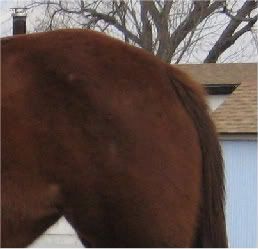
A real goose-rump
The Ideal Stock Horse and the RRQH it's based on is an extremely popular mold. The musculature is very realistic, his proportions are great and his flaws are few. I have a few nitpicky problems with this mold, but they are mostly production related. He's a little downhill, but some of the different mane styles of this mold cover this better than others. When buying an ISH as a show horse, always set him on a table and look at him from the front. Some ISHs are "base narrow" meaning their hooves are too close together. This isn't the original mold, but the result of minor warping in the plastic. His off side nostril isn't always prepped correctly and should always be carved out on a custom.
I like the Smarty...probably a little too much. I have a large conga line of them in my own collection and show them frequently. Because of this extreme position, every muscle in the sculpture is tense. This gives him the impression of being bulkier than he really is. If he were standing still I think he would look more like this:
However, I like seeing him in stock classes because he makes a great racing bred or high percentage TB stock horse. My only fussy issues are his small ears and slight discrepancies in the lengths of his legs bones (they're off--just a little.)
These three molds are interchangeable between all stock classes except mustang. While I know people show them this way, an ISH or Lady Phase is not a mustang. These molds are so easily recognizable as QHs/Paints/Appaloosas that I don't buy them as mustangs or another breed type. Mustangs have some characteristics in common with the stock breeds and their type varies widely. However, I've never seen a mustang with that much muscle. If you encounter a mustang that looks like the bay in this post, please forward me pics. I wanna see.
Silver is the most popular mold in the mustang class. He reminds me of a ferret.
If I left out your favorite mold, please let me know in the comments and I will gladly tell you why. ;)
Tuesday, December 22, 2009
What Molds Show Well: Foals
During this series I will present the molds I've seen be successful in the show ring. However, I can't repeat this mantra often enough: Collect what you love, show what you collect. If you don't like the Proud Arabian Mare, no number of ribbons will ever make you love that mold anymore. Having said that, it is helpful (especially to those of you with large and varied collections) to know which of your models to bring with and which to leave home.
These mold suggestions will apply both to original finish models and simple customs. Moderate and drastic customs are often altered to the degree that their flaws have often been eliminated.
I've split this series into breed groups with the intention to go class by class, following the typical classlist I outlined previously. I'm breaking it down this way because successful molds are predicated on the class they show in. There are some molds that are fine by themselves, but they may not win often at a show because there are better molds that they must compete against. On the flip side, there are molds that only show well because the competition in their class is so scarce.
Stock Foals
In a stock foal class, the Peter Stone Weanling reigns supreme. She was cast from the original resin Parrs Dream Doll by Carol Williams, also a very popular mold. There is very little to nitpick on this mold and she is a wonderful accomplishment by the sculptor.
If Breyers and Stones are shown together in OF or custom, the weanling is your best bet. However, they are split out or you are showing at a Breyer only show, you may consider the classic Mustang Foal, who is making a resurgence in popularity. The G2 foals (including the Running, Scrambling, and Scratching Foals) dominate this class in the mini division and can also hold their own when shown against traditional.
As with the stock division, I highly recommend Stone's option, the Arabian Yearling, over anything Breyer produces. For Breyer only, you can consider the Saddlebred Weanling, who has both his fans and detractors. The classic Arabian Foal, like his mustang counterpart, has come back in fashion with the increased popularity of Maureen Love's work. The Trotting Foal is also popular in both mini and combined divisions.
The twin foals, Amber and Ashley, show best in this division when shown as Morgans or a similar medium body breed. I've seen them have some success as stock foals, but--in my mind--they don't show any of the type I want to see in a stock foal at this age. Honestly, I don't really care for either of them as show models (I own a few and don't show them), but I that's not a hobby wide opinion.
Sport Foals
At the moment, this class is a crap shoot. I've seeing showers win with any of the breed I listed above for Light and Stock with odd breed assignments. Some are creative and make sense, but others are hard to believe.
I've seen a lot PS Weanlings shown as sport horses (often sport crosses, warmbloods, and even Thoroughbreds). I hate this assignment, but it's common and may win this class because of limited competition.
My favorites for this class are, again, the Running, Scrambling, and Scratching Foals. I think of them as the Rorschach test of model horses: whatever breed you see them as probably says more about you than the foals. They weren't sculpted to depict particular breeds (to my knowledge), plus their drastic movements and scale obscure any hints of type.
Outside of the minis, the new classic Warmblood foal is my favorite. His type his very obvious to me, although his conformation isn't completely perfect. But I'm mostly biding my time until Breyer releases Galen in plastic.
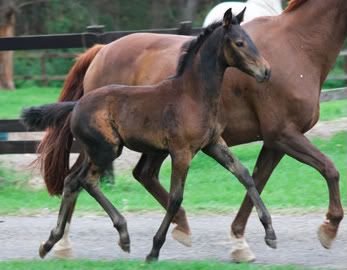
Sport foals are easiest to identify by their action
...you wanted more? No one remembers the last time this class was won by anything else. It's not as much as testament to the mold's quality (his legs are way too short) but to the lack of competition.
The most popular molds in this division are any of the above shown as one of the "near horse" breeds. By "near horse", I mean breeds that are short versions of standard horses such as the Quarter Pony, the POA, the Paint Pony. You can also through breeds like the Connemara, which has a high percentage of thoroughbred mixed in, to this category.
As in the Stock Foals class, the Weanling and Rorschach foals are very popular.
Monday, December 21, 2009
A Typical Breed Classlist
There used to be such a thing as the minimum guaranteed/core classlist. The be able give out NAN cards, a show must be approved by NAMHSA. Once upon a time (all of two years ago) a show had to offer a minimum list of a classes to be qualified. The show could expand the list and offer more classes, but it could never offer less. This rule was removed, but many shows are still based on the basic list.
The typical classlist you will see today will have more classes than were on the core classlist. For instance, the list only required one Draft class and one Pony class. Speaking as someone who has shows several draft and many more ponies, this sucked. In recent years, these classes have expanded to their own divisions with multiple classes each. There is also a very recent trend toward more Spanish classes with the success of new Spanish mold from Breyer.
The following is an example of a typical classlist:
Stock Foals
Light/Gaited Foals
Sport Foals
Draft/Pony Foals
Other Pure/Part Foals
Foal Breeds Championship
Quarter Horse
Paint
Appaloosa
Mustang
Other Pure/Part Stock
Stock Breeds Championship
Welsh Ponies
Other British Ponies
European Ponies
American Ponies
Other Pure/Part Ponies
Pony Breeds Championship
British Draft
European Draft
American Draft
Other Pure/Part Draft
Draft Breeds Championship
Thoroughbred/Standardbred
European Warmblood
American Warmblood
Carriage
Other Pure/Part Sport
Sport Breeds Championship
Arabian Stallion
Arabian Mare & Gelding
Part Arabian/National Show Horse
Morgan
American Saddlebred
American Gaited
Other Light/Gaited Pure/Part
Light/Gaited Breeds Championship
Andalusian/Lusitano
Spanish Gaited
Other Spanish Pure/Part
Spanish Breeds Championship
Mules
Donkeys
Exotics
Other Pure Breeds
Other Part Breeds
Other Breeds Championship
Classes can be split out from the current list. Usually the bigger the show or more popular division, the more split out the classes will be.
Friday, December 18, 2009
Basic Dressage: Pt. 2
Objectives of the FEI levels of competition
These tests are used worldwide.
PRIX ST. GEORGES: Test of medium standard. This test represents the medium stage of training. It comprises exercises to show the horse’s submission to all the demands of the execution of classical equitation and a standard of physical and mental balance and development, which will enable him to carry them out with harmony, lightness and ease.
(Depeche-resin, Caprice-resin)
INTERMEDIATE I: Test of relatively advanced standard. The object of this test is to lead horses on, progressively and without harm to their organism, from the correct execution of Prix St. Georges to the more demanding exercises of Intermediate II.
(Balling WB mare-resin)
INTERMEDIATE II: Test of advanced standard. The object of this test is to prepare the horses for the Grand Prix.
(Keltic Salinero, Stone half passing WB)
GRAND PRIX: Test of the highest standard. The Grand Prix is a competition of the highest level, which brings out the horse’s perfect lightness, characterized by the total absence of resistance and the complete development of impulsion. The test includes all the school paces and all the fundamental airs of the Classical High School, of which the artificial paces, based on an extreme extension of the forelegs, are no part. For this reason, the school leaps, no longer practiced in a great many countries, do not figure in the test.
(Deputed Duke, Lohengren, Kinetic Potential, Keltic Salinero)
There is also a Dressage test with jumps called Prix Caprilli, I would be happy to provide this test for anyone interested in another place to show your jumper.
Within these levels are a series of tests, the dressage tests can be found here and here.
When entering a model in a Dressage class it is important to list the level and the test that it is being shown, tests are also good ways to know what letter your horse should be moving past on the rail.
Please remember that Dressage, like model showing is a subjective sport with a set of judging guidelines, so any opinions are strictly that, I do have experience with my own real horses and I have trained from training level through Prix St George and am currently showing my new horse second level, with plans to move to third next year.
Laura back in: If you have any questions about this topic you would like to ask, please post them in the comments and I’ll ask Cassie to come answers them.
Thursday, December 17, 2009
The Hobby Police
Let's start from the beginning, shall we?
This is--no joke--my first custom. The blanket is white out and sharpie over enamel model paint. Sadly, this probably marked a high point in my first few years of my customizing career. Quality took a steep drop off as I discovered hairing, airbrushing, oils, and attempted to tackled any color that wasn't black. You should have seen how I created "roan" at the age of 13--and yes, I even tried to hawk it on eBay.
I have very little formal training past "coloring in the lines," so my current skill set is the result of years of trial and error. And in this hobby, you go through a lot of error. However, no amount of public humiliation was necessary to get me from this first attempt to my latest:
Honestly, I was a sensitive and emotionally unstable teen. Harsh criticism would have driven me to quit--without question. I was lucky that I started customizing in an era where the internet was new and access to the hobby came primarily through the Model Horse Gallery and MH$P. If I was getting a public dressing down on the Haynet, I never saw it. I never discovered a thread like this aimed at my work. Or this. Or this, or this...you get the idea. (Apologies to those of you that cannot see the above links as these threads are in a paid-only section. In fact, I've been unable to dig up a single fully public example of the Hobby Police in action.)
I don't intend to single out Blab or blabbers here, it just happens to be the community I know best. This behavior is hobby wide. There are lists devoted entirely to this purpose, although most are private. You'll see these kind of comments in blogs, other boards, and in person.
The Hobby Police follow a distinct pattern:
1. Find a target. This is most often an auction on a site like eBay or an ad on MH$P. In person, it will be an unattended model on a table.
2. Post a link with commentary. Sometimes the comments are constructive (the head is out of scale, the pattern in unrealistic, etc.) but most are mockery ("a rather unfortunate paint job," "Excuse me while I choke on my tea," or "Nice neck [sarcasm.]")
3. Defend their comments as "helping" the artist, who otherwise would not improve on their own. Example from one of the linked threads:
"You need to know when the time is right to put your work out for the public eye to scrutinize. This seller obviously doesn't know when that time is. I hope they keep painting and progressing and sooner or later they're going to look back and these pieces and say 'what the heck was I thinking when I put THAT on evilbay?'."The justification is that if they don't point out and "critique" young artists, those artists will never improve. Some critics will attack Big Name Artists (BNA's) as well, comfortable in the thought that they are contributing to the hobby by taking the artist's ego down a peg. The flaw in the logic here is that every artist I've met in the hobby, every--last--one, constantly struggles to improve. Most are easy going and down to earth people. Many (even BNAs) are very sensitive to criticism. These artists would leave a gaping hole in the hobby if they left.
Some already have.
There is no litmus test for artists. Newbies and BNAs alike, the quality of their work has no correlation to their personality.
Most of the discussion in the linked threads aren't pointed constructive criticism. It's a game. The authors don't write gently worded emails to the artist suggesting how they could improve their work or sales practices. They don't write because they know the response they receive will likely be curt and unwelcome. And that's not nearly as fun as mockery.
Artists, take heart! This kind of unwanted attack isn't about you. Never was. The point of the game is earn the respect of their peers by pointing out the supposed failings of others. They write this stuff because they want to feel like they are above the artist they attack. They are looking for positive feedback from their fellow hobbyists that their opinions of a particular model are valid, feedback they fear they won't get in direct communication with the artist.
The same goes when they attack the owners of custom work they don't like. Really, it's high school all over again. They want to be seen as the head cheerleader with the best taste in clothes.
The same behavior you see online will manifest itself in a different form at live shows. Personally, I believe a live show can be the greatest teaching tool for a hobbyist, but snark isn't helpful.
Next week, I will touch back on this topic as it applies to live showing. This portion of the hobby can be a shock for new showers (I know it was for me) but it doesn't have to sully your experience. There are techniques for dealing with them without ruining the fun of showing.
Posting Recommences
After recovering from the flu, I was just busy. Unfortunately, blogging the thing that had to fall off the edge of my schedule. However, my New Year's resolution is to get a better handle on my time and not fall off the face of the earth (blog-wise) again.
The long await part 2 of my previous will follow tomorrow (it's sitting at home on my Macbook--and I'm not.) I'm going to spend today getting to know the "schedule posts" feature of Blogger and get to a few topics I've been saving.
Tuesday, October 13, 2009
Get Your Flu Shot
Monday, October 12, 2009
Basic Dressage: Pt. 1
Basic Dressage for the Model Shower
Dressage is the training of the horse. It is not breed specific and is open to all horses and mules. This training is judged based on a series of movements within a test. Horses are shown at different levels based on their training, Intro level through 4th level are govererned by the USEF and the International levels, Prix St George, Intermediate I, Intermediate II and Grand Prix are governed by the FEI.
Arena
The Dressage arena is a 60 X 20 meter rectangle with a low fence. The Letters around the rail are A-K-V-E-S-H-C-M-R-B-P-F, G-I-X-L-D are not letters on the rail, they are considered invisible letters, and if they are seen they are small under the main rail letters.
Tack
Horses may be shown in any English saddle. The saddle must have stirrups and can be shown with or without a saddle pad (square pads are generally seen.) A Dressage saddle (long flaps) is required for FEI levels.
Bridles for training, first, and second levels must be a plain snaffle with a noseband. A simple double bridle is required for the FEI levels, and is optional for third and fourth level.
Numbers are generally small ovals worn on the side of the browband, just be sure that they are not pinching an ear or covering eyes.
Levels
(revised from USEF rulebook 2009)
These levels are the most important part of showing your model horse in Dressage. The horse should fit into one of these descriptions to do well. Dressage horses should be on the bit, quiet, forward and round over their topline. The models listed after each level are just examples, they can be interchangeable up or down a level and are by no means an exhaustive list.
INTRO LEVEL: A Walk-Trot test for the beginning horse or rider
(Breyer Marigold “Morgan”)
TRAINING LEVEL: To confirm that the horse’s muscles are supple and loose, and that it
moves freely forward in clear and steady rhythm, accepting contact with the bit.
(Peter Stone Pebbles WB, Breyer John Henry)
FIRST LEVEL: To confirm that the horse, in addition to the requirements of Training Level, has
developed thrust (pushing power) and achieved a degree of balance and throughness.
(Top Hat and Tails-Resin)
SECOND LEVEL: Through additional training, the horse accepts more weight on the hindquarters (collection), shows the thrust required at medium paces and is reliably on the bit.
(Utopia-resin, SM Cantering WB)
THIRD LEVEL: The Horse now demonstrates in each movement: rhythm, suppleness, acceptance of the bit, throughness, impulsion, straightness, and collection. There must be a clear distinction between the paces.
(Smittyn-resin, Meridian-resin)
FOURTH LEVEL: The horse has acquired a high degree of suppleness, impulsion, throughness, balance and lightness while always remaining reliably on the bit, and that its movements are straight, energetic and cadenced with the transitions precise and smooth.
(Dinky Duke-resin, Ricardo-resin)
Thursday, October 8, 2009
Collecting China Horses
How are ceramic horses made?
Earthenware is more common, easier to make in a home studio, but more fragile. Earthenware does not radically change during the firing process; it remains porous and grainy. It is the clay used by Hagen Renaker and Pour Horse Pottery.
Bone china is a bit more resistant to breaks, harder, and more expensive to produce. Like its “cousins,” porcelain and stoneware, bone china will vitrify, or fuse to a glass-like consistency, when fired¬¬—this makes these materials hardier than earthenware, which does not vitrify. Bone china has calcium carbonate—often from actual bones—in it. Horsing Around and Animal Artistry mostly use bone china.
China horses come out of their molds in moist clay form, called greenware. Greenware must be completely dry before it can be fired in a kiln. The resulting piece, from this initial firing, is called bisque. Bisqueware is the color of the original clay. Bisques can be finished in many ways—they can even be cold-painted.
(If a horse in its greenware state is resculpted or changed from its molded form, it is called a claybodied custom, and is automatically a glazed custom for show purposes, regardless of coloring.)
China horses are usually under-painted (also called "under-glazed") with fragile liquid clays (called slip) that have chemicals in them that change color when fired in a kiln—underglazed pieces then have a clear glaze applied over them and are refired (this is what Joan Berkwitz of Pour Horse does). Glaze is the powdered glass suspended in liquid that melts in the kiln to form a clear or matte protective coating that seals the color onto the china horse. Chinas can also be glazed first and then china painted, or over-painted with colors that are fired on and sink into the glaze (Karen Gerhardt does this beautifully). Whether underglazed or china painted, most horses require several firings to “bake” the colors and achieve the desired outcome.
Not all chinas are glossy. There are satin and matte glazes in use now, so the horse does not have to be shiny. Vintage Hagen Renakers have a matte glaze that cannot be used anymore for safety reasons, due to lead content; Britain does not have the same mandates as the US and may be able to use chemicals we can't, so matte glazes are commonly seen on British-produced horses. Many contemporary artists are having luck with "safe" matte glazes, but these can be tricky to work with—if applied too thickly, the matte glaze can frost and ruin the horse.
Bone china takes finishes differently than earthenware, and many bone china pieces are not finished with underglazes, but rather china painted, which will produce a different look to the finished piece. Bone china is not porous, so coloring it is different than earthenware—also, bone china is a cooler white, whereas earthenware is a warmer white—these differences effect the end results of underglazing the piece (for example, the same gray on a bone china will look more blue than on earthenware). Bone china generally involves more steps to completion than earthenware, although this also depends on the complexity of the finish.
What is the difference between OF chinas and glazed custom chinas?
OFs, or original finishes, are produced in large numbers; these can also be called production runs. One of a kind or glazed customs are generally produced by an individual artist, like Lesli Kathman or Adalee Velasquez.
Who makes china horses?
There are European-produced chinas (Royal Copenhagen for example) and US produced pieces like Hagen-Renaker.
Maureen Love (also known as Maureen Love Calvert) was the main Hagen Renaker sculptress for horses, and she sculpted all the beloved vintage pieces: Amir, Zara, Zilla, Heather, Harry, Adelaide, Kelso, Terrang, etc.
Other sculptors of note for vintage European pieces: Theodore Karner and Doris Lindner and Pamela DeBoulay.
Donna Chaney in the UK produces chinas as well as her resins, as does Horsing Around—Mark and Vanessa Crawley get rights to sculptures by many of the top resin artists (Eberl, Bogucki, Rose) and make them into chinas. Both these outfits mostly make bone chinas, although Donna Chaney has recently introduced a line of earthenware horses.
Some of the artists in the US that are making chinas: Joan Berkwitz of Pour Horse (earthenware) and MarcherWare (bone china); Lesli Kathman, Paige Easley Patty, Adalee Velasquez, Lynn Fraley, Karen Gerhardt, Marge Para, Kristina Francis, Karen Grimm of Black Horse Ranch, Lynn Raftis, Karen Dietrich, Jenn Danza, D'arry Frank, Sarah Minkiewicz-Breunig---this list goes on and on.
There is a world of fascinating pieces in the Made In Japan—literally—chinas, many of them knock-offs of Hagens. And there are way more than I've described---the Model Horse Gallery talks a bit about some of the china factories, too.
Why should I buy such a fragile horse?
Making ceramic figurines is a recognized art form that is thousands of years old. Both ancient and contemporary ceramic horses are beautiful, and bring feelings of enjoyment and wonder to the collector. With care, chinas will last for centuries. And they are more eco-friendly than plastic horses! Because coloring ceramic horses involves chemistry and heat, there is a magic to making them, never quite knowing exactly what the results will be. And because there are more limitations to the entire ceramic process, creating a perfect one is a complicated venture that can test the mettle of even the most talented artist.
Finally, ceramic horses tend to retain their value, and some (like vintage Hagen-Renakers) have exponentially increased in value over time.
Chinas—especially one-of-a-kind or OOAK—can be moderately expensive or gaspingly expensive; if you are used to original finish plastic prices, and paying $50 or $100 for a horse makes you wince, then chinas will make you shake your head and go "Huh?!" Mostly the expense involved in purchasing chinas reflects the amount of work going into them and their relative rarity. Bone china is much more complicated to fire, so it tends to be more expensive to purchase.
Still, some very nice pieces can be found for a few hundred dollars. Watching AuctionBarn or MH$P can still yield bargains. There are also Breyer china horses and the Lakeshore OF chinas that are reasonably priced.
How should I display my ceramic horses?
Can I show my ceramic horses?
One example: Breyer SM chinas are factory-produced by the hundreds, so if you were to show them, they would go in the OF china classes. Much like showing OF plastics, you want the horse to be in top condition, and since they are shiny, they also need to be very clean---no big fingerprints or wisps of dust, please! A OOAK piece would show in glazed customs, if such classes are available.
Do ceramic horses hold their value?
Where can I learn more about ceramic horses?
(The information written here is intended as an introduction; like most aspects of our hobby community, learning about ceramic horses is an on-going process—most chinaheads love to gab about china horses, so if you want to know more, ask them!)
Wednesday, October 7, 2009
Judging Chinas: Workmanship
There are many, many wonderful achievements being made by our top finish artists in glazed custom chinas—perhaps too many to go into here, but a high degree of knowledge and control are needed for the artist to produce realism in this medium; these things should be rewarded in workmanship classes. Things listed below denote excellence in glazed custom workmanship (as with items listed above, sloppiness should be judged as it would in any medium).
• Because ceramic molds are plaster of paris, therefore completely rigid, complex poses are very difficult to achieve; some sculptures are cast in pieces and require extensive assembly by hand after casting, making each piece almost an original sculpture. The more complex the mold, the higher degree of difficulty in making a finished horse.
• Because ceramic materials (earthenware, bone china) require both great delicacy of handling plus a lot of handling to complete, thin legs, tiny ears, body/coat texture, and similar refined details are harder to make in ceramic casting.
• Because ceramic underglazes are not remotely the color when applied that they will be when fired, getting consistent results with color, shading, and coat details such as dappling isn’t easy (in glazed customs, orangey or yellow palominos may have occurred due to the chemical changes to the pigments during firing, but an accomplished artist learns to control these things; realistic tone of coat color should be rewarded).
• Realistic details like multi-colored eyes, multi-colored hooves, hair texture, pinto mapping, dappling, haloed appaloosa spots, rabicano roaning, etc. require high levels of artistic skill and control; the more details on a piece (shading, pangare, tail frosting, dappling, even the number of different colors on the horse) the more times the horse has been in the kiln. Each turn in the kiln can negatively affect the final outcome; for example. colors can “burn out” or turn weird shades. So the more colors and details, the more difficult the piece was to finish.
• The smaller the horse or the larger the horse, the more difficult it was to make; there is reason why most china horses are “classic” scale!
• With ceramic horses, it is generally much easier to achieve good biomechanics if the piece is on a base; horses with correct motion/gaits that are not anchored to a base are more difficult to engineer and cast. This is even more true if the piece is bone china rather than earthenware.
• As with production run ceramics (OF chinas), crazing and breaks are not in and of themselves flaws; however, breaks should be expertly repaired and minimally visible. Flaws common in OF chinas should never be seen on glazed customs: overspray, hoof color or eye color flowing out of the natural area, flaws in the clear glaze or frosting in a matte glaze, weird greeny or bluey tones, air brush spatters, etc.
• Claybody custom chinas—horses that are resculpted to a new position before the initial, or bisque, firing—require a level of skill and delicacy (and bravery!) that denotes a high level of artistry; these pieces are basically original sculptures as well as one-of-a-kind colors.
• Some colors are hard to predict in fired finishes—realistic nose pinking and blue eyes require skill and planning on the artist’s part, because the more often these colors are fired, the more likely they are to fade.
Tuesday, October 6, 2009
Judging Chinas: Breed
There are a few things restricted by the ceramic medium that should be allowed for in your judging.
• Molding and casting can limit the level of fine detail in hair texture and is to be expected. However, judge lumpish, inexpert manes, tails, or feathering as you would on a resin or customized plastic.
• Glossy glaze can enhance richness of coloring, but reduce visibility of detail, particularly in areas of pure black or pure white.
• Certain colors are difficult to achieve with fired underglazes and overglazes, especially red bays and red chestnuts; truly superior pieces should have similar saturation of color to any cold painted piece. Color shifts are also harder to achieve—where a cold-painted horse might show both golden brown and gray shades within the coat color, this is harder to do in ceramics.
• Hyper-realistic details (individual hairs, striations of color in irises, multi-colored growth rings in hooves, hair-by-hair roaning, etc.) are very difficult to do in ceramic finishes, but oafish application of details should be judged as you would with any other medium.
Thursday, October 1, 2009
Breed Documentation: The What, When, Why, and How
What: For the purposes of Live Showing, “Documentation” generally means reference pictures, breed standards, or other valuable information about the breed you have assigned your model. It is displayed in front of or near your model on the Live Show table to be used as additional information in judging.
When: The most obvious time to use documentation is when your model is representing an obscure or relatively unknown breed. If you’ve been diligent in scouring through breed books and online Google searches to find a really great, new, rare, or odd breed, then it is best to share that new-found information with your judge. Show them that you did your homework and know your breed anatomy and standards. Some judges may have heard of your special breed, but others may not.
Another good time to supply documentation is if you have a common breed, but with a twist. Maybe you found a unique color that is not well-known within the breed, or an example of a real life horse that shows a different body type than what is automatically thought of in breed standards. Some examples would be Pinto Thoroughbreds or extremely stocky Australian Stock Horses (which are usually thought of as reflecting more sport-type conformation).
Or, maybe you have a pretty common breed or cross in mind for your model, but you’ve found a photo of a real horse that matches your model’s body type and color *perfectly*. This would be a good time to set that picture right in front of your model to show the judge that “yes, my model is a realistic representation of this breed/color/type and here is the proof in the photo of this real horse.” A warning though: do not overuse this form of documentation. Every horse, in every class, doesn’t need a picture matching the model.
In terms of the amount of information to include on your documentation, less is more! The judge does not have time to read through pages of information about a breed. If it’s a little known breed, include some info about basic characteristics, color, and their uses, with one or two pictures. For those more common breeds, stating the breed or cross breeds with some simple pictures will suffice. Using clear pictures and easy-to-read font is always a plus!
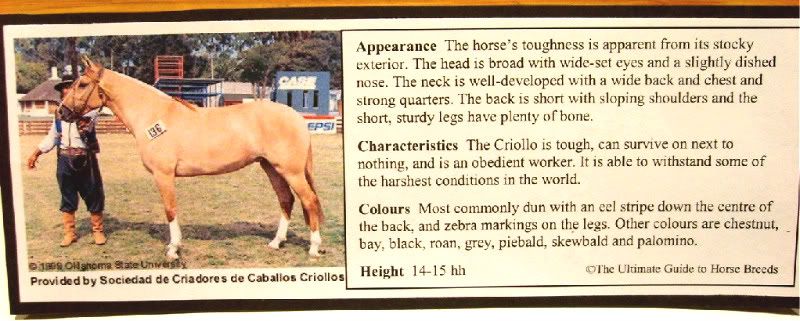

Wednesday, September 30, 2009
More About Callbacks
However, a judge won’t skip over a first place or champ horse to do this. If they decided one horse was better than another within a class or section, they shouldn't change their mind during a callback. A judge can only pick a second place or reserve horse for reserve or overall reserve and then only if the first place or champ horse that beat it wins champ or overall champ.
Clear as mud, right? As an example, let’s say I’m judging the Stock horse section callback. I’m torn between four horses: the first and second place paints and the first and second place mustangs. I like them all and would love to give them all rosettes (the big fluffy ribbons.) If I want, I can choose the first and second paints as champ and reserve respectively. I could do the same for the first and second place mustangs. However, if I chose the first place paint for champ, I cannot choose the second place mustang (or vice versa.)
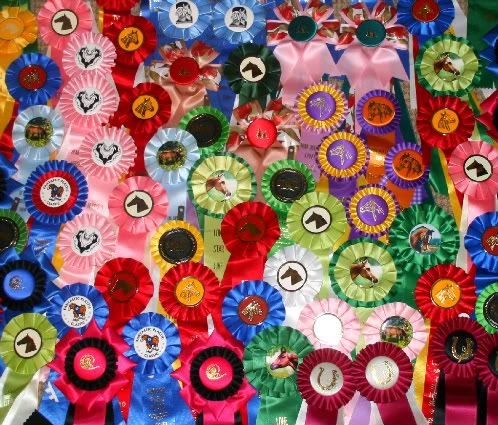
Fluffy!
Performance champs are usually a little different. Many judges choose overall and reserve based on points. Because performance horses show in several classes, they could have won several of each type of ribbon. Each place (1st, 2nd, 3rd on down) is assigned a point value with more points won for higher placings. The judge counts each horse’s points then awards champ and reserve to the first and second highest point totals.
Yesterday I mentioned that workmanship and collectibility are sometimes sections within a division. In this case, a judge may also choose their overall champ and reserve based on points. If a few horses stood out--winning both their green and yellow card sections--the judge will pick between them. Showers like this system because it is perceived to be more "fair" and shows that the judges has been consistent in her decisions throughout the day.
Tuesday, September 29, 2009
Show Structure and Callbacks
Divisions are often them broken down into sections. In breed classes, the sections are usually Foals, Light, Stock, Sport, Draft, Pony, and Other breeds. Sections then break down into classes. For example, the Stock section usually looks like this:
CM1. Quarter Horse
CM2. Appaloosa
CM3. Paint
CM4. Mustang
CM5. Other Part/Pure Stock
The last class, “Other Part/Pure Stock” is a common catchall class. Not all stock horses fit into the first four classes. Rare breeds and crosses go into this class.
Performance sections are usually split by discipline, i.e. all western classes are a section, all English are another section, etc. Workmanship and collectibility vary wildly and are sometimes included as sections with an OF, custom, or resin division.
After each section, there is a callback. All first and second place horses are brought back to the table so the judge can chose a section champion and reserve champion. When you see ads mentioning a horse has won a championship, they usually mean a section champion.
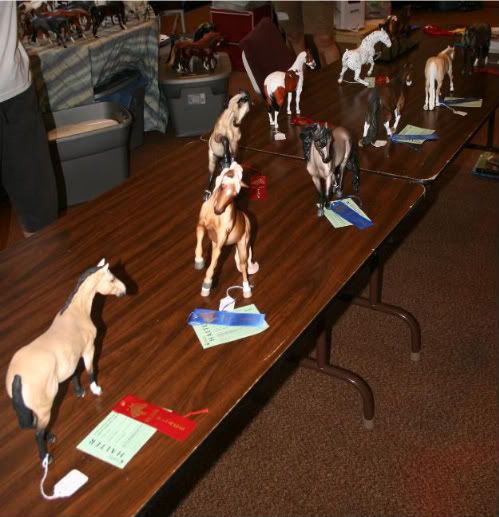
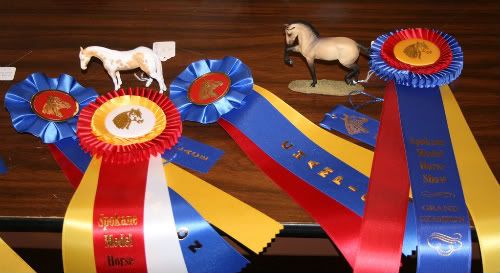
**A specialty show is held to feature one corner of the hobby. Common themes are performance only, OF halter only, custom finish halter only, Breyer only, Stone only, stock horse only, draft horse only, etc. Many of these shows are small with only a handful of showers and can be held in a living room or garage. However, not all specialty shows are small. Fantastic Plastic Classic and Evergreen Custom Classic are large annual specialty shows.
Monday, September 28, 2009
Workmanship Classlists
G1 - Repaint Only Trad Scale
G2 - Repaint Only Classic Scale
G3 - Repaint Only SM Scale
G4 - Etched Models Trad Scale
G5 - Etched Models Classic Scale
G6 - Etched Models SM Scale
G7 - Simple Custom Trad Scale
G8 - Simple Custom Other Scale
G9 - Major Custom Trad Scale
G10 - Major Custom Other Scale
G11 - Unrealistic Custom
S29 Black/Brown
S30 Chestnut/Sorrel
S31 All Grey
S32 Palomino/Buckskin
S33 Roan
S34 Dun/Grulla
S35 Other Color
S36 Pinto - Tobiano Pattern
S37 Pinto - Other Pattern
S38 Appaloosa Pattern
As a general rule, pinto trumps solid colors (including roan) and oddball colors (zebra stripes, brindle) trumps everything else. "Pinto" only includes horse with body white, so the baby above would show in chestnut. All Appaloosa colors (varnish, snowflake, blanket, leopard) show together. Roan only includes dark head roans and rabicanos. If you're still confused about where your horse should show, always ask the judge.
The final split, by breed, is my personal favorite. Horse are called up for their breed classes and are "double-judged," meaning two people judge the class at the same time. One looks at workmanship, while the other evaluates realism and conformation.
Double-judging is quicker because every horse only has to go on the table once. Also, it's an instant second opinion. If one judge doesn't care for your models, the other may have a more positive opinion. The downside is judges are often in too short supply to arrange this kind of classlist.
Thursday, September 24, 2009
What is Live Show Quality?
On the low end, it’s a meaningless marketing term thrown into every ad on MH$Ps. On the high end, it means 100% certified quality: stick it on the table and watch the ribbons roll in.
A few years ago, the incomparable Sarah Minkiewicz-Breunig wrote a very thorough definition of what the term means to her. She is describing the pinnacle of realism and the ideal artists strive for:
Live Show Quality Guidelines
It's a great article and well worth the read. I don’t agree with all of her opinions on conformation, but this is a good example of the varied and contrasting opinions you will encounter in the world of live showing.
This is your reading assignment for the weekend. There won’t be a pop quiz on Monday, but I’d like talk more about workmanship next week and this article is a good starting point.
Wednesday, September 23, 2009
Placing Your Models in the Ring
If a show hall has varied lighting then evaluate a table’s lighting before the show begins. If you have a horse with a ghost scratch or small flaw, place your model in a darker area. This will help keep the judge from seeing it as well compared to an overhead light emphasizing the flaw. However, if you have a model that has beautiful detail and the table has an area that is highlighted more by lighting then place your model in that area so that your model’s detail can be highlighted better.
I always try to find a spot on a table that isn’t real close to a Trad so that the bigger model doesn’t overwhelm them. Sometimes that is not possible in a big class but if there are other stablemates in the class I try to set my models next to them. It’s all about making sure the judge can get a good view of my model and not get lost in the crowd.
Laura in: As a judge, I love to see a class organized like this. If the class is big and the minis are already grouped, it encourages me to split the class into big guys and minis.
To help stablemates stand out and not get lost among the Trads in a class; place them on a base. You can buy beveled wooden bases at a hobby store for about a dollar. For some added touches, paint or stain your base, glue on model train grass or dirt, add flowers, tall grass or rocks. All of this can be bought at hobby stores or model train shops. Just make sure it’s not so heavily decorated that it detracts from the model and also check your show’s rules as some shows do not allow bases.
Laura in: You may also want to check with the judge. Some judges like them, some judges hate them, and some are indifferent.
Tuesday, September 22, 2009
Crossbreeds and Grade Assignments
Showing models as crossbreeds has its advantages and pitfalls. At many shows, they get a class to themselves, which is can be smaller than the purebred classes. Do you have a long conga of the same mold? Crossbreeds can allow you to spread them out through multiple classes.
Many molds, especially OFs, aren’t an exact replica of any breed. Companies like Breyer and Stone often stick implausible colors on molds, then leave it up to us to justify the combination of body type and color. In many cases, no purebred assignment can account for both body and color.
Over the years, I've collected a series of guidelines for showing crossbreeds. They aren't all universally accepted, but I think they increase the chances of success.
Limit your fractions
Since a horse only has two parents, you can only use half fractions--and halves of halves--and halves of halves of halves…and so on. That means 1/2, 1/4, 1/8, and 1/16. You can go smaller, but it’s not necessary. If a horse is only 1/16 one breed, that’s enough DNA to contributed a color gene but little to body type.
Include both halves
This is another difference between real world and model horse showing. Real horses (especially breed shows) often allow horses to be shown in halter as half-something without listing the other half. But real world judges don’t have to analyze realism or consider if a cross could possibly come in that color.
If you don’t list the other half, you leave it up to the judge to make-up, and that will rarely be to your advantage. An Arabian/Welsh Pony cross would look drastically different than an Arabian/Clydesdale or Arabian/QH cross. The right assignment can get a judge to look at a mold in a new light and forgive what they have previously thought of as a flaw in the mold.
Stick to believable crosses
Some crosses are more likely than other. Two members of different rare breeds may never meet in real life, let alone create a foal. Some crosses are unlikely because they’re impractical (Miniature to large draft horse) or the result is undesirable. Common, function crosses generally fair better than random-bred horses. They often have their own registries that have created a standard from which a model horse judge can work.
Always, always, always document
This is two fold: 1) Research allows you to discover if a theoretical cross really looks they way you assume it would, and 2) including the right photo can convince the judge that your model is an authentic representation of a real horse.
Finding the right photo can be tough if the cross doesn’t have its own supporting registry. Google image search can be hit or miss, so I often turn to online classified sites like Dreamhorse and EquineNow. These sites allow you to search by color and breed (and include secondary breeds.)
Remember, every cross has its devoted fans
And some of those fans are judges. (I have seen hundreds of QH/Morgan crosses. I know what they look like and how they move--you have been warned.)
No model horse is grade
“Grade” means a horse who’s parentage is unknown or mixed beyond recognition. Since we’re just talking about plastic ponies, their parentage is all unknown and it’s our job to make it up. I strongly dislike using “grade” as an assignment, even when the horse in question is a portrait model. This assignment doesn’t help your model at all, which is the job of a good breed assignment. As a judge, I tend to translate “grade” to mean “I gave up.”
Going back to last week’s Flash post, imagine one was shown as a “Grade Pony.” Maybe Flash is the perfect representation of a specific pony of hopelessly mixed heritage. But why would I pick a model with essentially no breed assignment over a model with an accurate breed assignment?
Thursday, September 17, 2009
Breed Assignments: Flash
Since today’s post is just about breed assignment, I’ve removed realism and basic conformation from the picture by using four horses of the same mold: Flash. This mold is nice example of a few things: A) he’s another example of a mold that doesn’t show well as the breed it’s meant to depict and B) he’s pretty generic and can shown as a number of different breeds.
Not all breed assignments are created equal. Some assignments are easier because the breed is common (or at least popular in the hobby) and no documentation is required. Some more obscure breeds can be researched with some ease via popular breed books. Other breeds are almost unheard of and may require you to speak a foreign language to track down enough information about them. For this post, I’ll be including levels of difficulty for each assignment.
Horse #1:
 Breed: Morgan
Breed: MorganDifficulty: Moderate to High
The difficulty here is justifying the pinto, pattern, and the body type for this assignment. Difficulty gets exponentially higher when you’re looking for all these characteristics in one real life example.
Horse #2:
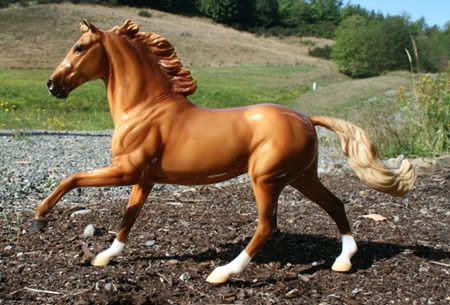 Breed: Connemara cross
Breed: Connemara crossDiffculty: Easy
This is the breed assignment of the original mold, the breed is considered common, and the color is well known in Connemaras.
Horse #3:
 Breed: New Forest Pony
Breed: New Forest PonyDiffuculty: Moderate
The trick with this assignment is his color. In the US, this color is called buckskin but in Europe (and by the Connemara registry) it’s called dun. Genetically, the terms dun and buckskin refer to completely different colors that look vaguely similar. This issue gets substantially cloudier because most Americans (including the Buckskin Regisrty…which you’d think would know better) also call dun “buckskin.”
*headdesk* *headdesk* *headdesk*
Horse #4:
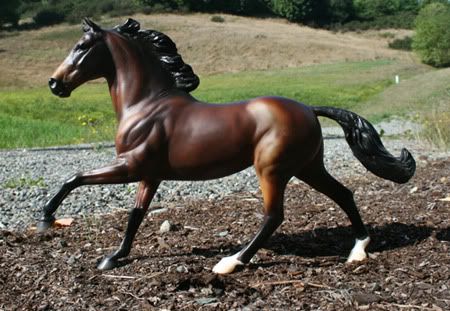 Breed: Quarter Pony
Breed: Quarter PonyDifficulty: Easy
A common breed in its most common color. No documentation needed, right? (Wrong…I’ll get to this in a minute.)
Feel free to take a minute and decide for yourself how you’d place this class (and feel free to post your placings in the comments. Don’t be afraid to disagree with mine just because it’s my blog.)
*
*
*
*
*
*
All done? Okay, my turn:
Forth place - Connemara cross
This is the most common mistake I see new showers make. If you are going to show a horse as a cross, please tell me what is was crossed with. I know in the real world that sometimes you don’t know a crossbreed’s exact mix, but these aren’t real horses. We’re making things up, so you might as well make up the other half, too. Saying a horse is just half one breed, but not another is kinda like doing half of your homework. (I’ll come back to crosses in more detail tomorrow.)
Third place - Morgan
Let’s say this horse was shown with photos of this horse and this horse for documentation. The documentation demonstrates that, although rare, pure-bred Morgans can both be overo and have dark legs on a palomino. A for effort, but his color isn’t my problem with this assignment. The Flash mold lacks several essential characteristics that make the Morgan unique. To make a better Morgan, his neck should be longer, arched, and cresty with a cleaner (thinner) throatlatch. His head should be longer with a petit muzzle and larger, hooked ears. To his credit, Flash has a compact, athletic body with those lovely massive Morgan feet I adore on my own mare.
Second Place - Quarter Pony
The Quarter Pony is a developing breed and their registry is open to horses of unknown parentage. As a result, you’ll see a lot of registered Quarter Ponies that look like Flash, athletic and generic. However, the registry specifically requires that “ponies must be easily recognizable as having characteristics of quarter-type or quarter bred ponies.” Again, the neck and head are an issue. His neck and headset should be much lower. Muzzle should be smaller and the head finer overall. I’d like to see larger hindquarters, as a Quarter Pony is ideally just a short Quarter Horse.
Having said that, judges are susceptible to persuasion. You can find numerous examples of athletic ponies of mixed heritage that are registered as Quarter Ponies and resemble Flash. A great photo showing a real life example makes a strong argument to a judge.
First Place - New Forest Pony
For once, a breed assignment that fits Flash’s head and neck! While you can find exceptions, short pony-eque necks and course boxy heads are common within the breed. Athletic bodies with horse like proportions are increasingly becoming the norm outside of the New Forest, as these native breeds have increasingly been bred for dressage, hunt, and jumping.
The trick with New Forest Ponies is that this is one of those breeds people think they know because they show up in a lot of breed books. Body types vary with Shetland pony-like proportions (long bodies, short legs) on one end and mini warmbloods (below) on the other extreme. As a shower, you have no control over which type a judge has in mind at the start of the day, but you can influence them to reassess their assumptions through good documentation.

Wednesday, September 16, 2009
Model Halter vs. Real Halter: Pt. 3
Breed books are an okay start, but they have an unfortunate tendency to be unspecific unclear, and inaccurate. Luckily, hobbyist Leslie Kathman has created a handy-dandy guide just for this purpose. Beyond that, there’s good ol’ Google Image Search, which is where you’ll eventually end up anyway trying to find photos for documentation.
As I mentioned on Monday, colors are often eliminated from a breed’s gene pool over time. Sometimes the color gradually withers away as a side effect of selecting for unrelated characteristics. Other times, the color is bred out intentionally because the color is considered undesirable. Registries will often take this one step further by not allowing horses that are the “wrong” color to be registered or approved. This is the case with the Friesian registry, which does not approve non-black animals for breeding.
The AQHA used to have a similar rule denying papers to foals with “excessive white markings.” Colonels Smokin Gun (Gunner) was one such foal:
 If he’d been born on the wrong farm a few decades earlier, Gunner would have been just another overly white foal to quietly “disappear.” Instead, he was registered with the APHA, despite coming from two QH parents.
If he’d been born on the wrong farm a few decades earlier, Gunner would have been just another overly white foal to quietly “disappear.” Instead, he was registered with the APHA, despite coming from two QH parents.That was until a few year ago, when the AQHA passed the following:
A horse having white markings with underlying light skin beyond any one of the following described lines shall be eligible for registration by AQHA only if it is parentage verified through DNA typing the offspring, its sire and its dam. Breeders should be aware that the American Quarter Horse, while long recognized, identified and promoted as a solid-colored horse, can and does occasionally produce offspring with overo paint characteristics. Such markings are uncharacteristic of the breed and are considered to be undesirable traits.In other words, they are happy to take your money in exchange for papers as long as you keep your pintos out of their halter classes.
And in the model world, chaos ensued.
On the one hand, we’ve always allowed unusual colors like chestnut Friesians, as long as they had appropriate documentation. Now, we have a rule that says they’re allowed but at the same time says they’re undesirable. What’s a model horse judge to do?
There isn’t a tidy answer for this problem and different judges have interpreted this rule in their own way. At this time, pinto QHs appear on a regular basis in at live shows. Disqualification is always a risk, but never a certainty.
Just speaking for myself, I disqualify them. I know its sounds hypocritical given my post from Monday and my allowance of other “undesirable” colors such as cremello QHs and chestnuts Friesians. However, we already have a separate class for pinto stock horses: the Paint class. In my opinion, a pinto shown in the Quarter Horse class is in the wrong class.
The primary reason you see pintos shown in the QH class has nothing to do with registry rules: the shower is trying to move their horse into a sometimes less competitive class. With few exceptions, the pintos seen in QH classes are minimally marked. The Paint class, for better or worse, frequently rewards loudly marked horses, putting these models at a disadvantage (which is also why you probably won’t see someone trying to show a solid-colored horse as a breeding stock paint.) This is especially true for custom-finish divisions, where workmanship and finish play a larger part in breed classes. Just as the louder patterns dominate in the paint class, these minimal marked models get a leg up against solid-colored models.
Is it fair either way? Not really. I’ve repainted minimally marked customs and resins to make them more competitive. Same body, same base color, but the pattern made all the difference. One of my current best show horses couldn’t win a NAN card until I extended his pattern. My advice is to keep this bias in mind when you decide whom to bring to a show.
This is my final installment of this series for the near future. Tune in tomorrow when I will delve deeper into breed assignments.


